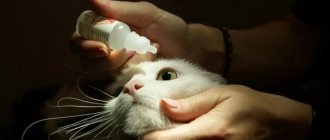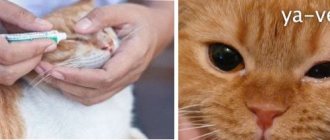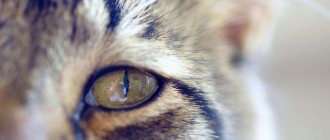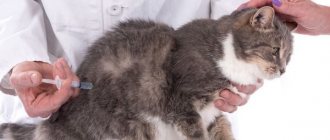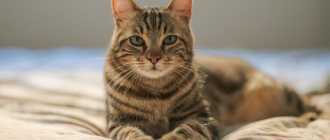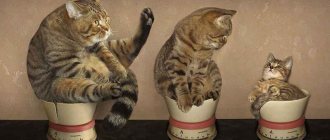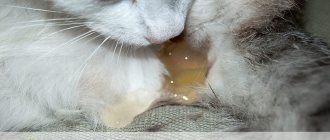Almost every veterinary specialist knows that an animal’s eyes are a “mirror” by which a specialist visually determines whether a cat is sick or not. Today in medicine, many human diseases are diagnosed by the eyes (iridology). Eye diseases in our cats are quite common today. If you do not take the necessary treatment measures in a timely manner, sometimes your pet’s disease can result in loss of vision. Before talking about eye diseases, cat owners should have an idea of what the eye is. A cat's eye is an organ specially adapted for the animal to perceive light waves. With the help of vision, your cat navigates the world around it, perceives the intensity of light, color, shape of objects, distance to them, as well as the movement of objects in space.
Domestic cats are more gentle creatures than their wild relatives. Of course, street cats' eyes fester just as often - this is due to their lifestyle. But when pus appears in the eyes of a pet furbaby, a caring owner will not ignore this alarm signal in any case. Each owner of his pet will strive to figure out why the cat has pus in the eyes, since this is a symptom that the cat is sick with something and will take the necessary measures to eliminate this situation.
Mycoplasmosis
Mycoplasma is a special type of microorganisms that occupy an intermediate position between bacteria and viruses.
In almost 90% of healthy cats this microorganism can be isolated, i.e. it is a normal inhabitant of the conjunctiva in cats. Mycoplasmosis in cats is an infectious disease that is characterized by the development of bilateral conjunctivitis with severe redness (hyperemia) of the entire conjunctiva, including the third eyelid.
Symptoms:
- Discharge from the eyes (tears, mucous or purulent discharge).
- Redness of the eyes.
- Sneezing, nasal discharge, and cough may occur.
— If both eyes of an animal are affected almost simultaneously, this indicates the infectious nature of the disease. If only one eye waters and turns red, then most likely it is conjunctivitis of non-contagious etiology. Often, mycoplasmosis in a cat disappears on its own after 7-10 days (if the underlying disease is eliminated and the immune system is strengthened). Otherwise, the disease becomes chronic.
- Joints are affected. At first the animal limps on one leg. Then it becomes noticeable that all the paws hurt. Mustache runs/jumps less. Getting up/ascending/descending becomes extremely difficult for the cat, so he sleeps almost all the time or lies down, meowing pitifully. The joints swell and do not bend.
- Body temperature rises.
Treatment
1. Treatment of the underlying infection using antibiotics and immunostimulants.
2. To treat conjunctivitis - eye drops with antibiotics.
============================================================================================================================================================================================
What first aid can the owner provide to a cat with purulent discharge from the eyes?
The first aid that the owner can provide to his pet is to wash the eyes. Washing the eyes of a sick cat is carried out with a decoction of chamomile, a 0.02% solution of furatsilin, a solution of boric acid (dissolve 2 teaspoons of boric acid in 500 ml of warm boiled water). Only a warm solution can be used for rinsing. It is better to carry out the washing procedure together, one person should hold the cat, and the other should carry out the procedure itself, this is necessary so as not to damage the cat’s eyes.
How to wash?
- A cotton pad, previously twisted into a tight rope, is dipped into the medicine, which is then squeezed onto the cat's sore eye. We carry out rinsing until all the pus is completely removed. After each wash, the cotton pads should be changed.
- Do not use dry cotton wool, as this may cause injury to the affected eye.
- After you have finished washing the eye, you need to put 1% tetracycline eye ointment behind the eyelid. To do this, we pull back the lower eyelid and coat its internal cavity with ointment using a special spatula. After this, close the cat’s eyes and lightly massage.
- When it is not possible to apply ointment, you can use eye drops: diamond eyes, sulfacetamide, chloramphenicol drops. The procedures described cannot cure conjunctivitis in a cat, they can only relieve its symptoms.
Only a veterinarian can cure eye disease.
Prevention
Prevention of the formation of pus in the eyes of a cat should first of all be based on eliminating the causes that lead to this problem in a cat.
- Cat owners should regularly prevent infectious diseases in the region, one of the symptoms of which is the appearance of pus in the eyes.
- Treat your cat quarterly for worms and ectoparasites.
- Prevent the cat from getting hypothermic; to this end, eliminate any drafts in the apartment. During a walk in severe frost and windy weather, the cat should not be kept outside for more than 10 minutes.
- Disinfect the premises and wet clean them twice a week.
- While walking, avoid contact of your cat with stray animals. If your pet received small wounds in the head area during a walk, then they need to be treated as soon as possible.
- Securely hide household chemicals from your cat.
- Conduct periodic preventive examinations at your veterinary clinic.
Symblepharon
Symblepharon is a fusion of the conjunctiva with the eyelids and cornea.
Symptoms:
Symblepharon varies in area of damage and localization: it can be partial or complete.
If it is small in size, it is sometimes an accidental finding during a general examination, but if it is of a significant size, it is already a cosmetic defect and interferes with the cat’s vision, but the symblepharon itself does not bother the cat.
With partial symblepharon, when the conjunctiva may not fuse with the cornea, the prognosis is favorable; with complete symblepharon, the prognosis is most often unfavorable.
Treatment:
1. Daily eye sanitation.
2. Separation of the conjunctiva from adjacent layers, the cornea, using local preparations with antibiotics and steroidal anti-inflammatory drugs.
3. In case of severe symblepharon, leading to visual impairment, the option of surgical treatment to separate the fused tissues is considered.
============================================================================================================================================================================================
Disease prevention
In order for your pet to get sick less often, he needs to take preventive measures, namely:
- A small pet should wash its eyes daily;
- When playing with an animal, it is necessary to take all measures so that the kitten does not get injured;
- All vaccinations must be done on time;
- The animal's nutrition must be correct and balanced;
- Take your pet to the vet regularly.
Caring for your pet is a very important aspect of pet care. After all, this is the only way your baby will grow up healthy and happy.
Obstruction of the nasolacrimal duct
Normally, tears should flow out through a special channel that runs inside the nose (nasolacrimal duct), but if this outflow path is disrupted, the tear has nowhere else to flow except outward, to the area near the eyes.
Symptoms:
- Various degrees of lacrimation and brown coloration of the fur around the eyes (formation of “tear tracks”).
This may be a breed predisposition - as congenital pathology is often found in Sphynx, Persian, British, exotic, Scottish and other short-faced cats; or as a consequence of inflammatory processes in the eye area.
Treatment:
1. If the obstruction is associated with overgrowth or blockage of the nasolacrimal duct, then surgical dilation of the canal is possible. 2. But most often, with this problem, it is enough to carry out daily hygienic care using special lotions to remove tear ducts.
===========================================================================================================================================================================================
Establishing diagnosis
Before starting treatment, it is imperative to conduct a diagnosis that will help identify the true cause of excessive lacrimation and carry out effective treatment therapy. Only a veterinarian can conduct a correct and thorough examination.
Important! Before going to the veterinarian, be sure to prepare a pet card, which should indicate all vaccinations, anthelmintic treatments, and past illnesses. It is advisable to write down symptoms of malaise and other suspicious signs on a piece of paper.
Sometimes the veterinarian may be interested in the following important questions at the appointment:
- how long the symptoms last;
- how did the first symptoms of tearing from the eyes appear and the peculiarities of the course of this condition, for example, did two eyes immediately begin to water at the same time, or vice versa, first one began, and then the other, and whether there are other additional symptoms;
- when the last procedures to eliminate helminths, fleas, ticks and other parasites were carried out.
To make an accurate diagnosis, the veterinarian will definitely take a urine and stool test. It is advisable to already have the research material with you before going to the doctor. Also, at the appointment, he will definitely take mucus from the eye for examination; for this reason, there is no need to first rinse the pet’s eyes with various solutions.
Conjunctivitis
This is an inflammation of the outer layer of the eye, which is normally pink in color.
Symptoms:
- Redness of the eye,
— Discharge (can be transparent in the form of a tear, mucous, purulent)
- Squinting of the eye, local itching.
Treatment:
1. Use of local and systemic antibiotics and antiviral, and, if necessary, local antiallergic drugs.
============================================================================================================================================================================================
Breed Features
Another variant of the norm for increased mucus secretion in cats is determined by the breed. This feature occurs in cats with a flattened muzzle. This characteristic is accompanied by disruption of the nasolacrimal duct and nasopharynx. As a result, the outflow of fluid worsens and excessive accumulation occurs in the organs of vision.
Prominent representatives of these breeds are:
- "Persians";
- "British";
- Exocote;
- Scottish Fold (Scottish Fold cat);
- Manul;
- Himalayan cat.
In addition to increased mucus accumulation, these cats may experience problems associated with nasopharyngeal congestion. Snoring, frequent snorting and noisy eating are not uncommon manifestations in these breeds. Owners should carefully care for their pets and prevent the development of a pathological condition. Regular visits to the veterinarian will be helpful for this.
Protrusion (loss) of the third eyelid gland
Symptoms:
— A red or pink formation appears in the inner corner of one or both eyes.
- Discharge is usually in the form of tears or mucus in small quantities.
Treatment:
1. Surgical, preference is given to repositioning the gland rather than removing it, since this gland accounts for 30 to 50% of the total amount of tears produced.
============================================================================================================================================================================================
What to do if your cat has a swollen eye?
A swollen eye can easily frighten an impressionable owner; he will not know what to do. If a cat's eye is swollen, you should never poke your fingers into it. Carefully take the animal's head and position it so that the eye is clearly visible. Don't forget to pay attention to whether the cat can see. This can be easily determined by shining a bright light into the swollen eye: the pupil should narrow.
Any responsible breeder should practice disease prevention. The pet needs to be vaccinated, monitor its diet, examine it every day, and groom the cat. Do not self-medicate, pay attention to the slightest changes in the behavior and general condition of the cat’s body. It is better to go to a veterinary clinic for a preventive examination than to lose a pet due to your own carelessness.
Entropion of the eyelids
This is an incorrect position of the upper and/or lower eyelids, in which the free edge of the eyelid is shifted inward towards the eyeball.
Symptoms:
— Eyelashes and hair on the eyelids, when turned in, greatly irritate the eye.
— The cat squints its eyes a lot.
- There is severe lacrimation or purulent discharge. Constant irritation can lead to corneal injury.
Treatment:
1. Surgical. With spastic volvulus, therapy is aimed at eliminating the underlying disease, but in some cases, after eliminating the cause that caused the spastic volvulus, it is still necessary to resort to surgical correction.
============================================================================================================================================================================================
Causes of allergies
There are, in fact, as many allergens as there are substances and compounds known to man. In other words, the cause of an allergic reaction on the eyeball (conjunctiva) and the skin around the eyes can be anything: plant pollen, any food, household chemicals, animal hair, bird down and feathers, house dust (infested with microscopic mites), insect bites, hygiene and cosmetic products, medicines, sweat, saliva or hair of other people, etc., etc. At the same time, to this day the etiopathogenetic mechanism, which in one person “triggers” an individual violent (in some cases catastrophic) reaction to any substance, has not been thoroughly clarified, while the body of another person remains completely indifferent to the same substance. However, the role of congenital predisposition, as well as the cumulative (cumulative) nature of the allergenic effect, has been reliably established.
Corneal ulcer
This is an inflammation of the cornea, accompanied by its defect.
Symptoms:
- Squinting (blepharospasm)
- Watery or purulent discharge, pain.
— You may notice a roughness, indentation, or whitish spot on the surface of the cornea.
Treatment:
Depending on the severity of the process:
1. Medication (antibiotics, keratoprotectors, etc.)
2. Surgical.
============================================================================================================================================================================================
Is this an allergy?
To establish an “allergic” diagnosis in ophthalmology, it is necessary, first of all, to carefully analyze the clinical picture and history, including hereditary predisposition, cases of allergies in blood relatives, similar reactions suffered by the patient in the past, allergens known to him and specific to him, dependence on the time of year, presence of pets in the apartment, etc. Laboratory blood tests are prescribed - in particular, the concentration of allergic markers - eosinophils, immunoglobulin E is studied. The most accurate way to identify an allergen, if it is unknown, is a series of intradermal injection allergy tests, however, even when testing the reaction to hundreds of potentially allergenic samples, there is no guarantee that it will be found the substance that is the dominant allergen for a given patient.
Uveitis
Inflammation of the iris and ciliary body - structures located inside the eye.
Symptoms:
- Squinting, redness and clouding of the eye.
- Constriction of the pupil.
— Precipitates on the corneal endothelium (small white dots on the inner surface of the cornea)
— Exudate (effusion) in the anterior chamber of the eye
- Decrease in intraocular pressure.
Treatment:
1. Local corticosteroids, non-steroidal anti-inflammatory drugs, mydriatics and systemic drugs.
===========================================================================================================================================================================================
Glaucoma
This is an increase in intraocular pressure due to a decrease in the outflow of intraocular fluid. This pathology leads to a narrowing of the visual fields, and ultimately to complete loss of vision. Glaucoma can be primary or secondary (against the background of the underlying disease). In cats, glaucoma most often occurs after the age of 6 years and is secondary.
Symptoms:
- Redness of the eye
- Watery eyes, squinting (blepharospasm)
- Pupil dilation and signs of concomitant disease (uveitis, tumors) may be observed.
— In the case of an acute attack of glaucoma, the eye becomes cloudy, tortuous vessels on the surface of the eye are clearly visible and severe pain, the eye may increase in size.
Treatment:
1. Drugs to lower intraocular pressure.
============================================================================================================================================================================================
Why do eyes suffer from allergies?
The eyes are among the “favorite targets” and areas for the development of allergic reactions. The tissues and structures of the eyeball are thin, very sensitive, not very well protected from the harmful influences of the external environment - and therefore especially vulnerable. The cornea, eyelids, eyelashes, sclera, conjunctiva are in direct contact with the air, where particles of countless substances are contained in suspension, as well as with rain and tap water, with cosmetics, shampoos, creams, eye drops and gels, and contact lenses. In addition, in close proximity and in direct communication with the orbit there are many other equally vulnerable mucous membranes (nose, oral cavity, etc.). The eyes are also susceptible to allergic reactions to substances that enter the body, for example, to individually allergenic foods and medications.
